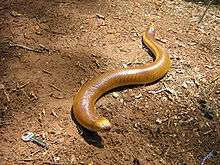Amphisbaenidae
| Amphisbaenidae | |
|---|---|
 | |
| Amphisbaena alba | |
| Scientific classification | |
| Kingdom: | Animalia |
| Phylum: | Chordata |
| Class: | Reptilia |
| Order: | Squamata |
| Clade: | Amphisbaenia |
| Family: | Amphisbaenidae Gray, 1865 |
| Genera | |
|
17, see text | |
The Amphisbaenidae, common name worm lizards, are a family of amphisbaenians, a group of limbless vertebrates.
Geographic range
Amphisbaenids occur in South America, some Caribbean islands, and in Sub-Saharan Africa.
Taxonomy
One deep-branching and somewhat aberrant genus, Blanus, is native to Europe, and may represent a distinct family.[1]
Description
Members of the family are limbless, burrowing, lizards with carnivorous diets. As in other amphisbaenians, the body bears rings of scales, which gives amphisbaenids a worm-like appearance. The heads are massively constructed and used for burrowing, with powerful jaws and large, recurved teeth used for seizing prey. Some species have spade-like heads, while others have a narrow keel on their heads, and still others have a rounded skull.[1] The eyes are highly reduced, while the ear bone, or stapes in the middle ear, is large and massive. Together with another bone, the extracollumella, the stapes detects vibrations caused by prey items, allowing amphisbaenids to hunt for invertebrates underground. In this respect there apparently is evolution convergent to the burrowing mammalian family Chrysochloridae, in which the malleus in the middle ear is greatly enlarged.[2][3]
Genera
Over 120 species are in the family, grouped into 17 genera:
- Amphisbaena Linnaeus, 1758
- Ancylocranium Scortecci, 1930
- Anops Bell, 1833
- Aulura Barbour, 1914
- Baikia Gray, 1865
- Bronia Wiegmann, 1828
- Cercolophia Strauch, 1881
- Chirindia Boulenger, 1907
- Cynisca A.M.C. Duméril & Bibron, 1839
- Dalophia Gray, 1865
- Geocalamus Günther, 1880
- Leposternon Hemprich, 1820
- Loveridgea Tornier, 1899
- Mesobaena Mertens, 1925
- Monopeltis A. Smith, 1848
- Zygaspis Cope, 1885
References
- 1 2 Gans, Carl (1998). Cogger, H.G.; Zweifel, R.G, eds. Encyclopedia of Reptiles and Amphibians. San Diego: Academic Press. p. 216. ISBN 0-12-178560-2.
- ↑ Mason, Matthew J. (2003-08-01). "Morphology of the middle ear of golden moles (Chrysochloridae)". Journal of Zoology. 260 (4): 391–403. doi:10.1017/S095283690300387X. ISSN 1469-7998.
- ↑ Mason, Matthew J.; Narins, Peter M. (2001-01-01). "Seismic Signal Use by Fossorial Mammals". American Zoologist. 41 (5): 1171–1184. doi:10.1093/icb/41.5.1171. JSTOR 3884562.
Further reading
- Gans, C. 2005. Checklist and Bibliography of the Amphisbaenia of the World. Bull. American Mus. Nat. Hist. (289): 1-130.
External links
| Wikispecies has information related to: Amphisbaenidae |